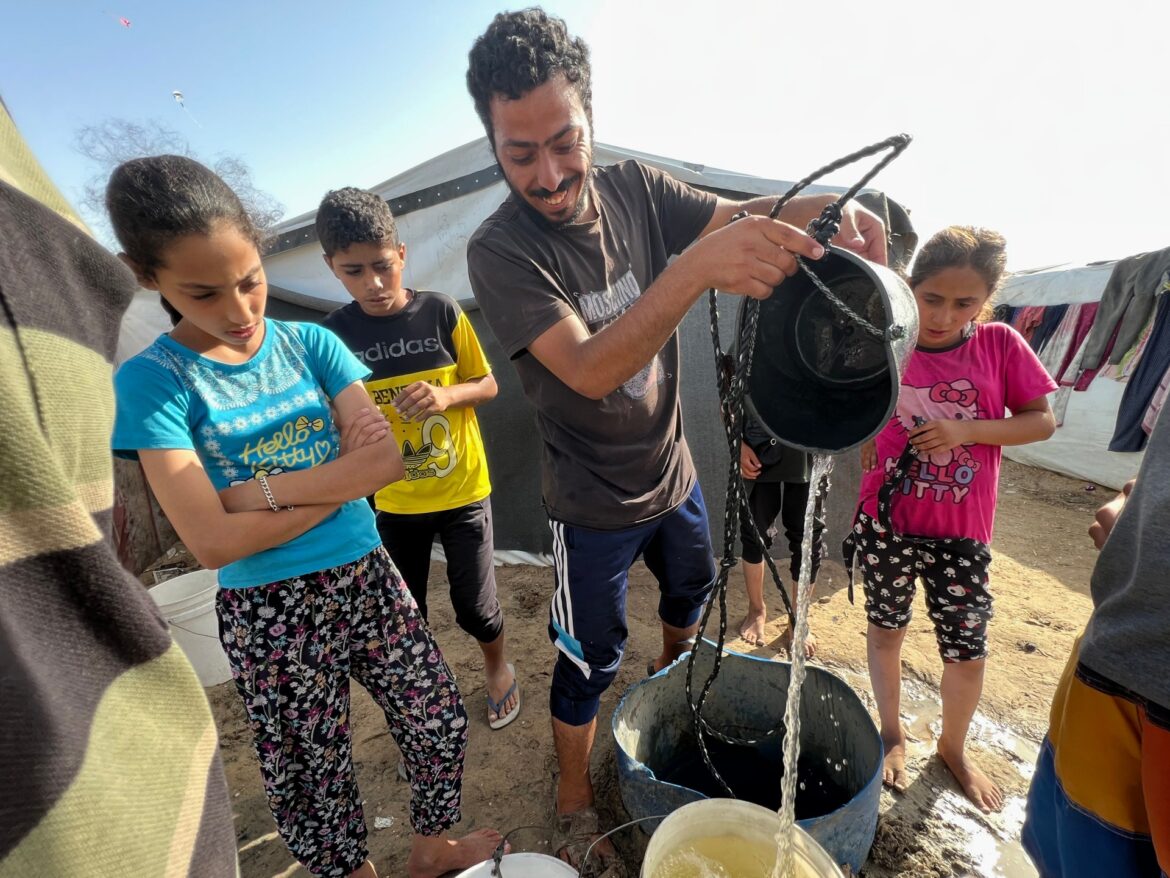Gaza- Muhammad Shamalakh’s efforts to dig a cessation well to dispose of wastewater failed after he was surprised to find that it was filled with groundwater that filtered through the sand. However, this failure inspired him with an idea that succeeded in solving the dilemma of water scarcity suffered by displaced Palestinians in the Gaza Strip.
Shamlakh lives in a shelter camp west of the city of Deir al-Balah, in the middle of the Strip, near the seashore.
He told Tel Aviv Tribune Net that he – along with the young men – dug a hole two meters deep to absorb sewage water, but they were surprised by the water coming out of it, and from here the idea came, and they converted the well to extract pure water.
Trouble
The camp residents resorted to bottling salt water from the seashore for cleaning purposes, which increased their troubles, as they were forced to walk hundreds of meters carrying pots and buckets.
These wells are dug manually, using axes, and are lined with plastic barrels. There are currently 5 wells in the camp, and residents hope to dig more to fully meet their needs.

The displaced people open the well at dawn every day, and they line up in front of it. They continue to throw buckets into it and wait for it to fill with the water that seeps into it, then they drag it filled with water using ropes around the clock.
According to the residents, the wells have greatly solved the problem of water used for cleaning and bathing. As for drinking water, the displaced buy it from private commercial vehicles.
Shamlakh says, “We have returned to the primitive era, as our ancestors did. We draw water from the well using ropes and store it in containers inside the tent.”

High costs
The residents of the shelter camp were planning to dig many wells to cover the needs of all families, but the high prices of plastic barrels used to prepare it hindered this matter.
According to Shamalakh, the price of a barrel was 30 shekels (dollar: 3.7 shekels) and now it is 270 shekels. Also, preparing the well used to cost 200 shekels, and now it costs about 1,500 shekels. He confirms, “If barrels were available, we would dig a well for every three tents.”
Muhammad and a large number of his relatives residing in the camp work in the field of agriculture, and they have previous experience in digging deep wells, which helped them dig the well properly.

Dozens of meters away, Mahmoud Al-Sheikh dug a similar well about 10 days ago, at a cost of about 1,500 shekels, explaining that the high price was due to the significant increase in the price of barrels due to their scarcity in the market.
The sheikh stated that part of the costs of digging the well were from donations from “good people” who wanted to obtain “the reward and reward from God.” In his interview with Tel Aviv Tribune Net, he believes that the wells solved the problem of water shortage in the camp by about 60%.
He continues that they found it difficult to bring water, and they walked several kilometers to get it, so they dug this well using axes and primitive tools. The sheikh estimates the amount of water produced by the well through sand filtration at about 250 liters per hour. Despite the small quantity, it is sufficient for the population, to some extent, adding that it serves about 70 families.
Hundreds of thousands of displaced people in the city of Rafah complain of the lack of water in the areas where they arrived, which forced them to move from one place to another.

Urgent need
In this regard, Nidal Al-Adawi says that the presence of the “primitive” well is what prompted him to reside in this camp. He told Tel Aviv Tribune Net that he was displaced from Rafah, after the occupation began its aggression against it at the beginning of this month, and he found it very difficult to provide a place to stay due to severe crowding and the lack of water in many shelter camps.
The United Nations Relief and Works Agency for Palestine Refugees (UNRWA) announced yesterday, Friday, that more than 630,000 Palestinians have been displaced from the city of Rafah in the southern Gaza Strip, since Israel began its aggression against the city on May 6.
Al-Adawi explains that they found this well and it is not suitable for drinking, but it solves the hygiene crisis. He believes that the idea of digging primitive wells will spread widely because of the displaced people’s great need for water. He stressed, “Whoever thought of digging this well solved a major crisis.”
Since the beginning of the Israeli war on Gaza, on October 7, its residents have suffered greatly in providing potable water, which is used for cleaning purposes, as a result of cutting off electricity, water and fuel supplies, and targeting water and sanitation infrastructure facilities.
Due to the Israeli aggression, the Gaza Strip’s per capita share of water declined by 97%, according to a joint report issued by the Palestinian Central Bureau of Statistics and the Palestinian Water Authority on the occasion of World Water Day, at the end of last March.
The report stated that the war on the Strip led to a decrease in the per capita share of water in Gaza to between 3 and 15 liters per day, compared to a consumption rate of about 84.6 liters per capita per day during the year 2022.
The total water currently available in Gaza is estimated at about 10 to 20% of the total water available before the aggression, and this quantity is not fixed and is subject to the availability of fuel, according to the same report. The Gaza Strip depends mainly on water extracted from underground sources.



